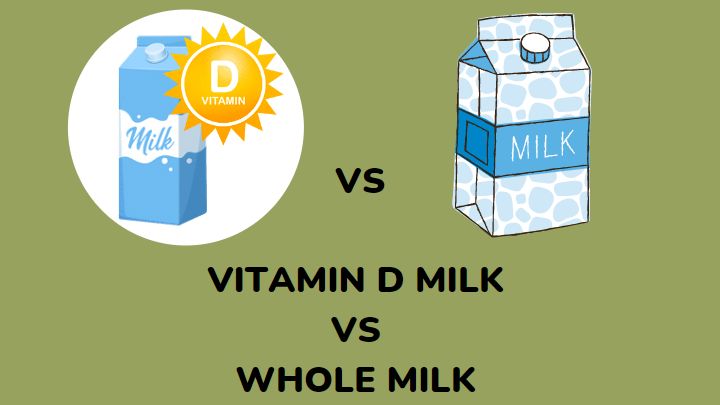Vitamin D milk vs whole milk, Is vitamin D milk the same as whole milk?
The different types of milk in the store are getting people quite confused because of the labels they carry.
Some packs of milk carry a “fortified with vitamin D” label, and some do not. It begs the need for a comparison of vitamin D milk vs whole milk. It’s also okay if you want to know which milk out there is the healthiest.
Ahead, this article provides a detailed comparison of vitamin D milk vs whole milk and which of them you should be drinking.
What is whole milk?
Whole milk is cow’s milk that still has all its fat composition. This means that all the fat naturally present in the milk remains in it even after processing.
Moreover, whole milk is thicker than other types of milk that contain less amount of fat. The nutritional value of whole milk will depend on the brand of milk.
Generally, whole milk contains a 3.25% fat composition. In addition, 1 cup of whole milk contains an average of 140 calories, 7g fat, 7g protein, 12g carbs, vitamins, and minerals.
What is vitamin D milk?
Vitamin D milk is whole milk that contains vitamin D.
One cup (8 ounces) of vitamin D milk is whole milk fortified with at least 100 International Units (IU) of vitamin D. This is about 24% of the Daily Value (DV) of vitamin D.
In addition, milk that has gone through fortification with vitamin D carries labels like “enriched with vitamin D” or “with vitamin D.” Also, check the ingredients list for vitamin D3.
Is vitamin D milk the same as whole milk?
Yes, it is.
Vitamin D milk is whole milk that has been fortified with vitamin D. Some brands label their milk with vitamin D, while some leave it as just whole milk.
In a case where whole milk does not contain vitamin D, there will be no vitamin D label. Additionally, other types of milk like reduced-fat and non-fat milk also have vitamin D varieties.
Why add vitamin D to milk?
Vitamin D is added to whole milk because whole milk does not contain vitamin D. Vitamin D is necessary to play roles like:
Increase calcium absorption
The fortification of whole milk with vitamin D helps the body to better absorb the calcium that is naturally present in milk.
Vitamin D works together with calcium to increase bone strength and keep bones healthy. Vitamin D and calcium also work together to prevent rickets in children.
Prevent vitamin D deficiency
If you drink up to two glasses of whole vitamin D fortified milk daily, you’ll be getting a good amount of your daily value of vitamin D.
Although drinking milk that contains vitamin D can help prevent vitamin D deficiency, you should not rely on milk alone to provide you with all the vitamin D you need.
Increases immunity
Whole milk that contains vitamin D increases immunity against autoimmune diseases. Drinking this type of milk improves cell growth and enhances the function of the immune system.
In addition, whole milk that has gone through fortification with vitamin D can help reduce your risk of getting cancer. It prevents the growth of cancer cells and the onset of autoimmune diseases.
Improve heart health
Vitamin D is a heart-friendly vitamin. It keeps the heart healthy and reduces the risk of getting heart disease.
Drinking vitamin D milk also helps to address the risk factors that lead to heart diseases. It helps to reduce blood pressure, remove bad cholesterol and strengthen the blood vessels.
FAQs
Should babies drink vitamin D milk or whole milk?
Once your baby can start taking milk (which is after one year), you can give them whole vitamin D-fortified milk.
Does non-fat milk have vitamin D?
Yes, it does. Non-fat milk or skim milk contains about 25% of your daily vitamin D need.
What is the difference between vitamin D milk and 1% milk?
The difference between vitamin D milk and 1% milk is the fat composition.
Vitamin D milk or whole milk has a 3.25% fat composition, while 1% milk has a 1% fat composition.
Conclusion
Vitamin D milk is no new milk after all. It is whole milk that has been fortified with vitamin D for a target group of consumers. However, not every whole milk is vitamin D milk.
If the milk pack doesn’t say “vitamin D milk”, it does not contain vitamin D.
Vitamin D is added to whole milk, which does not naturally contain the vitamin. Moreover, this vitamin is necessary for certain functions like enhancing calcium absorption and preventing diseases.
I hope this article fully answered your questions on the comparison of vitamin D milk vs whole milk.
Thanks for reading.
Visit Millenora to read more informational comparison articles.
